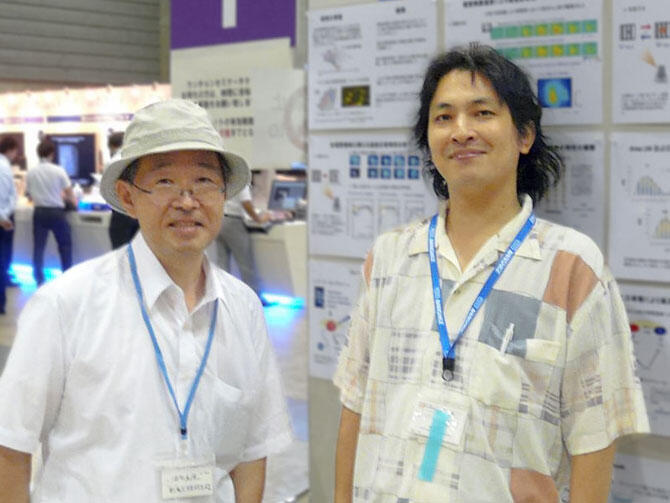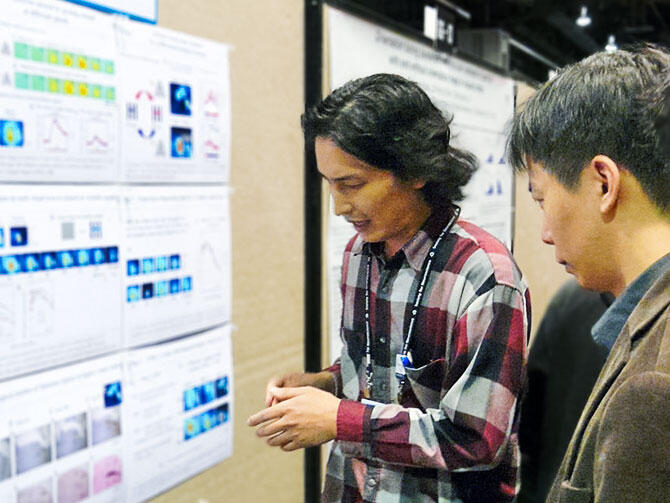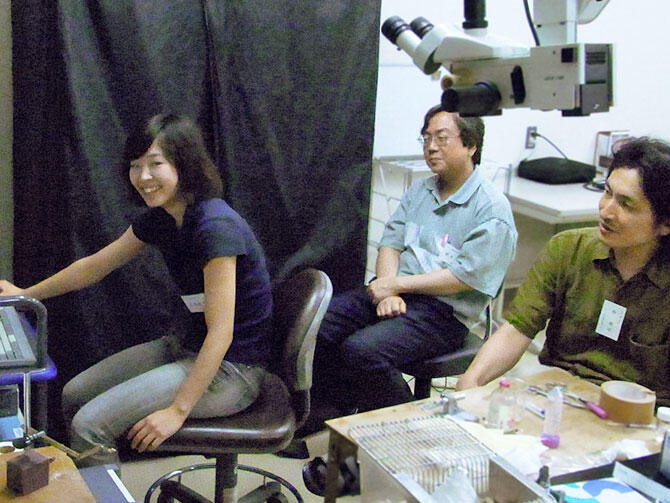
Manabu Tohmi
University of Virginia, USA
Interview
Dr Tohmi obtained his PhD from Niigata University, under the supervision of BRI Prof Hiroyuki Nawa, then joined BRI Prof Katsuei Shibuki's lab to continue his work on the visual cortex. He later transferred to the Technical University of Munich, Germany and is currently working at University of Virginia, USA. In this interview, Dr Tohmi shares his experience at BRI and his current work.

With Dr Shibuki (left) at the scientific meeting.
What research did you do when you were at BRI?
When I was a vet student, I was interested in animal behavior and became a member of Prof Nawa' s lab as a graduate student, wishing to study the relationships between brain and behavior. The main focus of my research was on animal models based on the cytokine hypothesis of schizophrenia, which postulates that inflammatory cytokines released by infectious diseases affect the brain in the prenatal and infant stages, leading to the onset of schizophrenia symptoms in adolescence or later. Peripheral administration of various cytokines to young rats and mice and analysis of their behavior after maturation revealed abnormalities in behavior that are thought to be related to schizophrenia. In addition, changes in the expression of various molecules in the related region of the brain were observed. I learned about molecular biology and behavioral pharmacology through my research, and I also had many opportunities to learn about neuroscience at BRI. There were a wide range of study and peer-review groups in the lab. We have ties with many neuroscientists at the School of Medicine and I learned from them too. I attended a peer-review session on neurophysiology run jointly by BRI Dept of Neurophysiology and Dept of Physiology at the School of Medicine, which led me to join Prof Shibuki's lab as a post doc and later as an assistant professor. I started to study the visual cortex of mice using a technique developed by Prof Shibuki called flavoprotein fluorescence imaging, which visualizes neural activity on the surface of the brain. There was no one else in the lab studying the visual cortex, and I had no experience in the area either. As it turned out that we were free from traditional approach to do research on what we were interested in, and the atmosphere in the lab encouraged us to enjoy free thinking. We eventually achieved a world-leading success in visualizing the higher visual cortex of mice functionally. The higher visual cortex consists of several areas that exhibit functionally distinct visual response properties. Back then, the different response of each area was considered to be based on hierarchical input from the primary visual cortex. However, we have shown that the differences in the rate response properties of the higher visual areas are based on input from a visual pathway that does not pass through the primary visual cortex, but through an evolutionarily older visual center, the superior colliculus.

Poster presentation at SfN while in Shibuki Lab. With Dr Jianhua Cang, his current lab leader.
Tell us about your current research.
After 15 years at BRI, I continued my research in higher vision at the Technical University of Munich, Germany, and now at University of Virginia, USA. The study on the higher visual cortex in mice has only just begun and we need to learn its basic nature. Previous studies have shown that neurons in the visual cortex respond selectively to specific features in their receptive fields, such as stimulus orientation and motion direction. Neurons in the visual cortex also show selectivity for movement in certain directions. We sought to determine the relationship between the tilt of the neural tip in the higher visual cortex and the selectivity for motion direction. In the process, we found the cells that respond to the motion streak produced by an object that moves at a high speed. To study motion processing in mouse visual cortex, using moving dots and drifting and static gratings, we performed two-photon imaging that measures the activity of hundreds of neurons. Many of the fast parallel cells show a direction selectivity to moving dots. Notably, many other cells preferred the parallel axis in the high-speed range but did not show any preferences of the motion axis in the low-speed range. This study indicates that motion streak responses in the mouse visual cortex. We also found that the speed at which the motion streak responses is different among visual areas. We also found neurons that respond only to motion streaks. Psychological experiments in humans have shown that information from the motion streak plays an important role in the perception of movement. The response of neurons to motion streaks in mouse visual cortex makes specific predictions on how mice might perceive visual motion.

At BRI summer seminar, giving guidance on flavoprotein fluorescence imaging to participants.
What is your future plan?
One of my main research interests is to understand how the higher visual cortex is formed and how it functions. The study of the higher visual cortex was mainly carried out in monkeys before the use of mice. Developmental studies with monkeys have been difficult due to various restrictions. We have now measured, for the first time in the world, the response properties of individual nerves in the higher visual cortex of mice immediately after eye opening, when they have no visual experience. Neurons in the higher visual cortex responded to specific inclined lines and directions of movement already without visual experience, albeit with less selectivity. This finding is important for understanding the process of functional development of the higher visual cortex. I will continue my research on the functions of the higher visual cortex and the superior colliculus. But I come to think that I need to take a fresh look at the visual functions of mice and other rodents, which are widely used in research. Putting aside research using advanced measurement techniques for now, I am aiming to establish behavioral experiments to evaluate visual cognitive functions in rodents, which have not received much attention so far. I believe that this is important, albeit in an indirect route, for clarifying how the brain processes information.





